Painting, decorating and home improvement tips blog
How to paint a front door
Posted by Adrian
May 18th, 2015
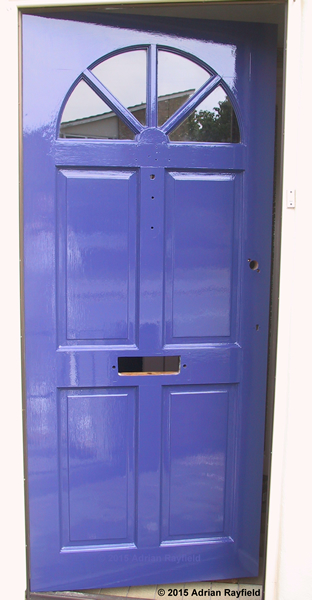
How to paint a front door
From time to time you will need to paint your front door, if it is wood that is. Ideally pick a couple of dry days to complete the job such as spring or summer. Pick a good quality exterior paint to ensure a long lasting job.
The front door is one of the most seen parts of your house, a good looking door gives a good impression to visitors, and especially if you are selling your house as it gives kerb appeal.
You should gather all the tools required before starting, you will need:
- Screwdrivers
- Adjustable spanner
- Sandpaper (various grades)
- Primer
- Undercoat
- Topcoat (Satin or gloss)
- Paint stripper (optional)
- Heat gun (optional)
- Scraper (optional)
Ironwork / Door furniture
The first job is to remove all ironwork or door furniture such as locks, knocker, letterbox, escutcheon, door pull and numbers. This will make it far easier for working on the door. Put everything to one side being careful not to lose any screws as some can be tiny and you will need them again later to refit the ironwork / door furniture. You may need an adjustable spanner for the knocker or letterbox.
Preparation
As with all decorating jobs, preparation is key and will take most of your time. Now is the time to decide if you are simply going to re-decorate your door, or give it a real overhaul and strip the existing finish off back to bare wood.
If you are going to remove all the existing paint finish you can do this either by using a heat gun and scraper, or paint remover and scraper. The choice is really up to you. Once the door is stripped give it a good rub down and fill any crack and holes and sand these level and smooth. Once you have done this you are now ready to move to the next section, prime.
If you decide against stripping the door back to bare wood, or it simply doesn’t need it you should give the existing surface a good clean off to remove dirt and grime with a cloth and maybe water, the give the surface a good rub down. Fill any cracks or unwanted holes and rub them down level and smooth. Dust off and you can move onto the next section, prime.
Prime
Once you have prepared the door you should prime the entire door if you have stripped it back to bare wood, or spot prime bare wood if you have just rubbed down and filled. Allow to dry before moving onto undercoating.
Undercoat
Once you have primed the door, whether it be the entire door or spot primed, give the primer a light sand down before applying one or two coats of undercoat. Allow each coat to dry fully if you give it more than one coat sand back between coats for that perfect smooth finish.
Topcoat
Once you have prepared the door correctly and given it it’s necessary coats of primer and undercoat you can now give the door it’s final sand back and the final coat, the topcoat. This maybe a satin finish or a gloss. Again you may want to give two topcoats, but read the manufacturer’s instructions to ensure you leave enough time between coats, and a word of warning, if you sandback, you a fine paper and use light strokes. If you are too harsh you could scratch the surface too much, or even worse roll up the first coat and ruin all your hard work.
Non-painted or varnished doors
This post deals with painted doors, such a glossed doors but for other finishes, such as varnish or stained door the principle is the same, apart from you wouldn’t use primer or undercoat, however the preparation part is still applicable and needs to be done.
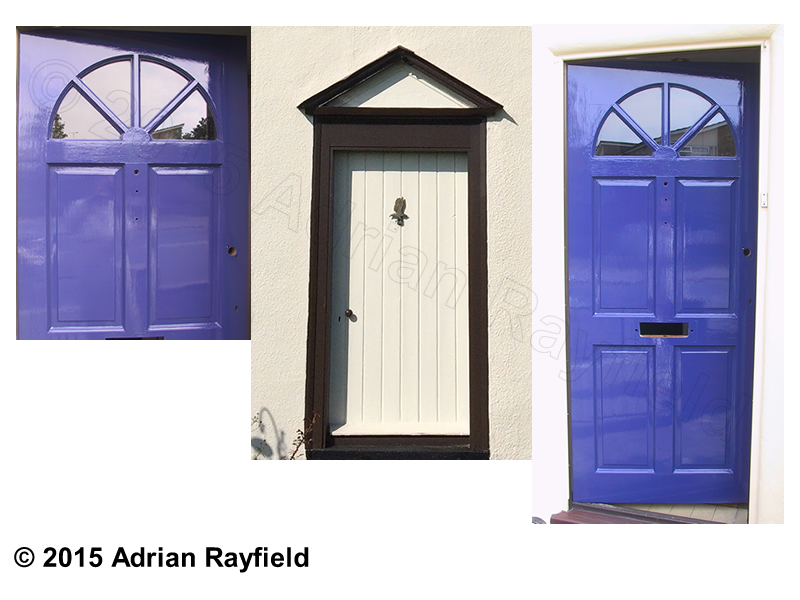
Tags: Door, Door Furniture, Filler, Filling, Gloss, Ironwork, Knocker, Letterbox, Lock, Paint, Painting, Preparation, Primer, Satin, Topcoat, Undercoat, Varnish, Woodstain
Posted in Decorating Tips | 1 Comment »
Review of Dunlop Pro Decor Flexible Acrylic Filler caulk
Posted by Adrian
March 9th, 2015
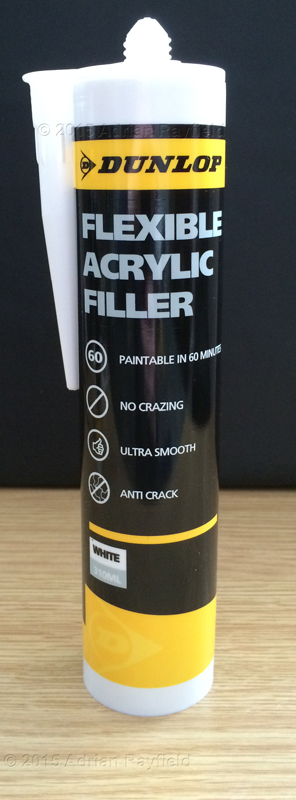
Review of Dunlop Pro Decor Flexible Acrylic Filler caulk
I recently received a tube of Dunlop Pro Decor Flexible Acrylic Filler to try and review, there has been a bit of a buzz over this product from professional decorators like myself, why, you ask, well because of its claims not to crack and its anti crazing properties. Now unless you use caulk daily like us decorators you may not know the ongoing problem we have when we use caulk and paint over it.
I have written about this problem before on this blog, Tips on using decorator’s caulk, also on Rayfields Interiors, How to use decorators caulk and also Fillers – knowing which one to use and on the Improving Your Property blog, What is decorators caulk / filler.
So when I got this opportunity to try this product and give a review I was very keen to do so, could this really be the end to cracking and crazing filer?
The tubes are filled with a white acrylic filler and come in a 310ml tube, allowing easy application by using a caulking gun.
I have tried the product and here is my review.
My review of Dunlop Pro Decor Flexible Acrylic Filler
On the Dunlop Decorators website it says this about the product:
FLEXIBLE ACRYLIC FILLER™
A high performance gunnable filler which can be used internally and externally for filling skirting boards, window and door frames as well as repairing cracks and damage to walls and ceilings.
- Paintable in 60 minutes
- No Crazing
- Ultra smooth
- Anti-Crack
I was very keen to test the no crazing and anti-cracking claims.
I tried the acrylic filler on my last two jobs, I have used it around skirting boards and ceilings, and painted over it with different types of paint, including water based primer /undercoat, gloss, satinwood and emulsion. I also noted the drying time and smoothness once dried.
The result
I was pleased to be able to try this acrylic filler and see if it met all of it’s claims, which for me it did. It seemed to dry fast allowing me to paint over it quickly. For the normal troublesome emulsion crazing / cracking issue I can say I didn’t come across any of this issue so was really impressed. Once dry the filler left a smooth surface that didn’t show once pained. I also didn’t see any cracking once it dried, I tried this product in both small and large gaps and had the same results.
In conclusion
I was very please with this acrylic filler, and from a professional decorators point of view the fact it stand up to it’s claims and doesn’t crack or craze like many other brands of decorator caulk, this is something we have been waiting for for years.
Now that I have used this product I will certainly be changing over to use this acrylic filler all the time and will certainly be wanting to try Dunlop Pro Decor’s other fillers such as deep hole filler and fine and lightweight fillers in the future.
Buy Dunlop Pro Decor Flexible Acrylic Filler caulk
You can buy Dunlop Pro Decor Flexible Acrylic Filler caulk from My Paintbrush.
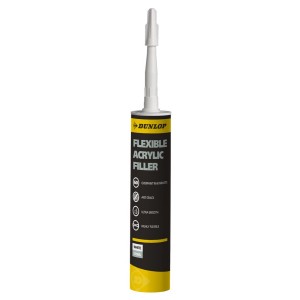
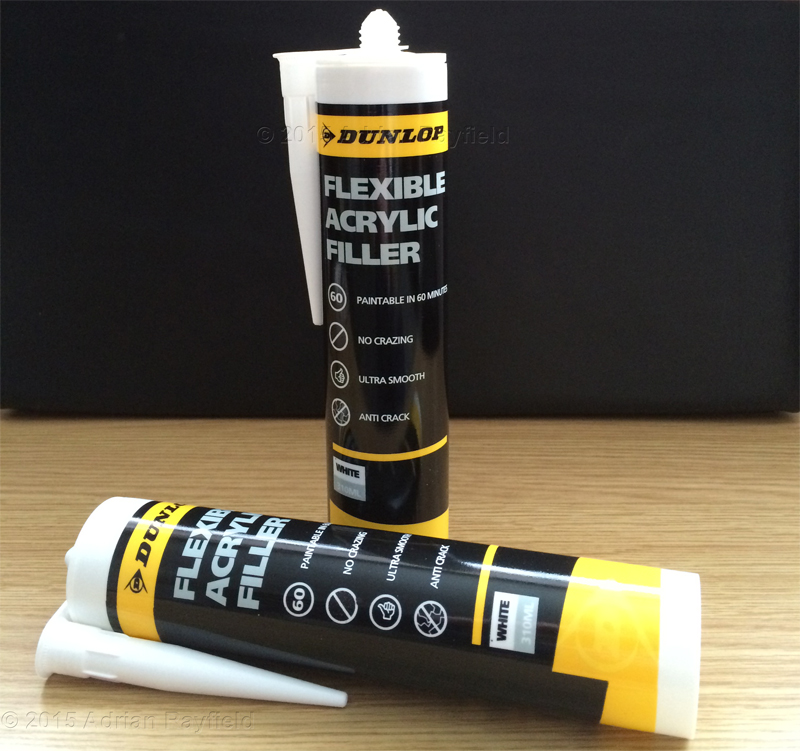
Tags: Acrylic, Ceiling, Cracking, Crazing, Decorators Caulk, dunlop, Dunlop pro Decor, Emulsion, Filler, Skirting Boards
Posted in News, Resources, Reviews | 12 Comments »
How to wallpaper
Posted by Adrian
November 30th, 2012
How to wallpaper
When it comes to wallpapering you must prepare the walls properly first otherwise the paper will not adhere well to the wall, cracks, missing plaster, rawl plugs and filler will show through. Getting the preparation right is very important and around 90% of the job. Once you have removed any old paper, filled and sanded down the walls and sealed any new plasterwork, you are ready to begin.
Choosing your wallpaper
Before you buy your wallpaper you will need to measure the walls of the room, or just one wall if you are just doing a feature wall. We have a wallpaper calculator that is quick and easy to use to work out how many rolls of wallpaper you need.

Tools for wallpapering
You will need some tools to wallpaper well and to make you life easier, the following tools are what you will need.
- A paste table
- A clean bucket
- Wallpaper paste
- Rolls of wallpaper
- Paste brush or a roller
- Rolls of wallpaper
- Wallpapering brush
- Pasting brush or a roller and tray for paste
- Clean water
- Sponge or clean cloth
- Tape measure
- Pencil
- Step ladder
- A knife or sharp scissors
- A plumb line
Getting ready to hang the first sheet
Once you have gathered everything together and prepared the walls for wallpapering check your rolls of wallpaper, make sure none are damaged, check to make sure the batch numbers are the same and the shade is the same on all rolls. If they are not the same you can either change them for the same batch or shade codes or work out how many you have of each batch and use these on the same wall, you can get away with different batch numbers or shades codes by using them on an area that doesn’t show or just on a different wall as the light falls differently around the room. Ideally all number should match.
Next mix your paste to the manufactures recommendations, unless your using ready mixed paste of course. Set up your pasting table and take the first roll of wallpaper, unwrap the roll and unroll a length onto the table, familiarise yourself with the pattern and look for the repeat if there is one.
Now take the plumb like, measure out from a corner 2cm less than the width of the sheet of paper, mark the wall then using the plumb line mark a vertical line down the wall.
Hanging the first sheet of wallpaper
Measure from the ceiling to the top of the skirting boards, cut a length of paper off the roll allowing about 5cm at each end to trim the top and bottom of the sheet. Lay the sheet of paper of paper face down on the clean paste table, apply your mixed wallpaper paste onto the back of the sheet from the centre to the edges, make sure the edges are well covered. Concertina fold the sheet and then allow to soak in accordance with the manufactures instructions. Once the paper has soaked for long enough take the top of the sheet and align it with the plumb line you made earlier. Take your wallpapering brush and smooth out the paper and pushing out any air bubbles, start from the centre and work out to the edges.

Once the sheet is smoothed out you will need to trim the top and bottom of the paper with either a sharp knife of a pair of scissors. Now wipe down the paper ensuring you remove all paste from the face of the paper. Wipe down the paste table surface and dry, now paste your next sheet of paper.
Now cut and paste the second sheet of paper and butt the edge up to the first sheet, work the edge down, smooth out as before and wipe the surface, continue doing this until you get to a corner.
Wallpapering around an internal corner
When you come toward a corner, measure from the edge of the last sheet hung to the corner, do this in several places. Take the widest measurement and add 2cm to it then cut a sheet of paper that width. Paste the sheet, once soaked hang as described before but this time wrap around the extra paper around the corner.
Now you can take the other half of the sheet you just cut, or a new sheet (depending on pattern) and measure it’s width. Mark with a plumb line that width from the corner a vertical line. Paste this sheet and then align it with the plumb line and work into the corner allowing it to overlap the paper you have turned the corner with, use a border or vinyl to vinyl adhesive to stick down the edge in the corner.
Wallpapering around a door or window
I recently wrote a post about wallpapering around a door so won’t go to it in detail here, but what I will say is always make sure that you have a straight plumb line as you come out of papering around the door or window as if it isn’t straight you will have problems with the next run of paper!
Papering around switches or sockets

The easiest way is to take switches and sockets off, but DO NOT DO THIS unless you know what you are doing, you should never mess around with electricity! So to leave them on and paper around them, switch off the power, paper over the switch or socket, you an see where the edges of the face plate are, from the centre cut to the corners of the face plate. Now carefully trim the flaps you’ve just made but leaving enough to tuck behind the face plate. Now unscrew the face plate just enough to get the paper behind, carefully ease the plate through the hole in the paper, you will find the plate moves a little so it’s easy to tuck the paper behind, just be careful not to tear the paper.
Screw the face plate back on, wipe the paste of the switch with a damp not wet cloth or sponge, then dry. Now turn the power back on.
You should now have beautiful wallpapered room.
If you found this post of use, please share it via the buttons below, also feel free to comment on this or any other post.
Tags: Cracks, Filler, Paste, Rawl plugs, Tools, Wallpaper, Wallpaper stripping, Wallpapering
Posted in Decorating Tips | 2 Comments »
